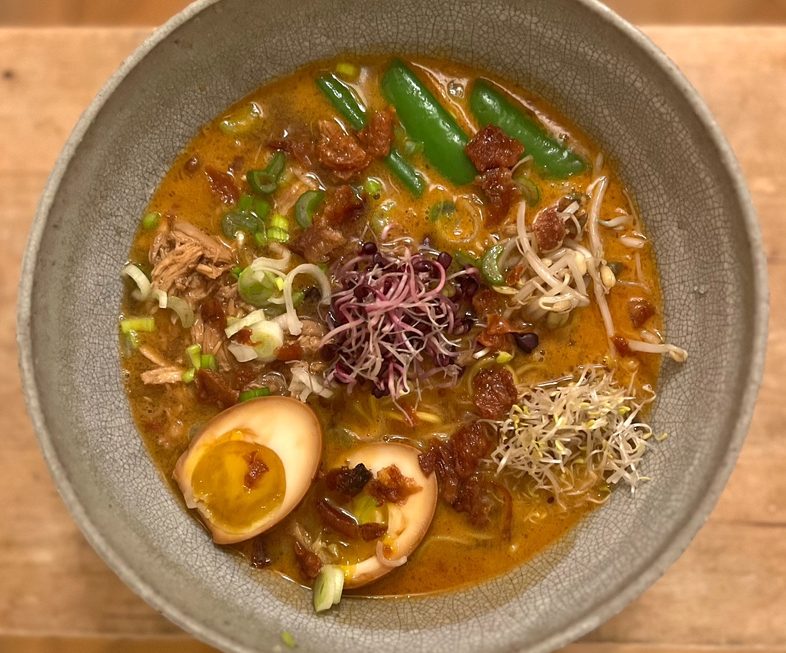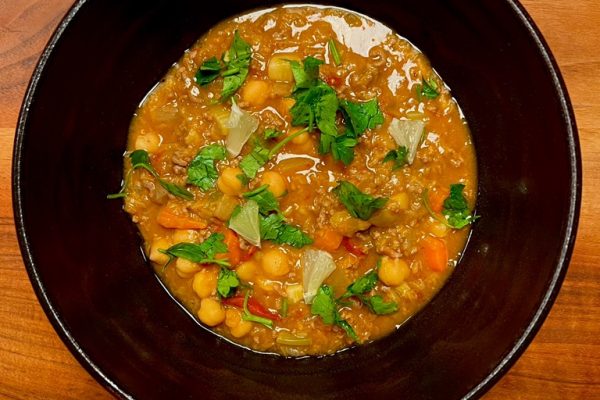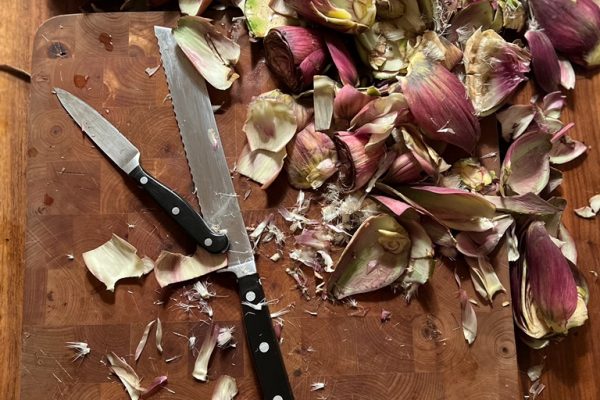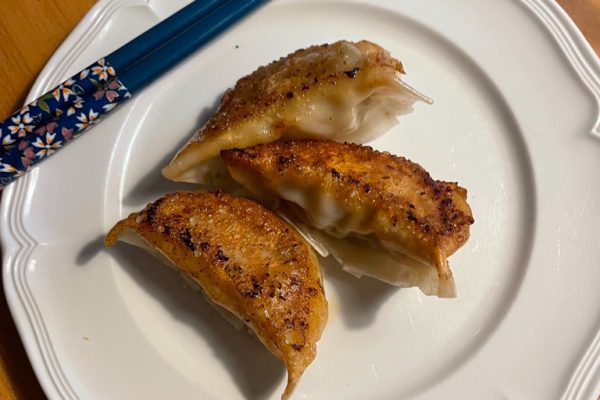Our next ramen is based on a chicken broth and gets its typical character from sesame paste, garlic and doubanjiang, a Chinese spice mixture of chilli and fermented beans.
In contrast to what we explained with our vegan shoyu ramen, today we deliberately do not use two broths that are combined afterwards.
Instead, we want to show how you can also cook a complex broth with the ingredients of a dashi in one go (the double stock variant nevertheless remains our recommendation).
We start with a classic topping for ramen, namely marinated eggs (Ajitsuke Tamago). Of course, this was out of the question for the vegan versions.
If speed is of the essence, you can use a simple soft-boiled egg, but the full flavour experience requires a build-up of at least 8 hours to two days – so plan accordingly.
The eggs should be at room temperature and then carefully pierced at their thick end with a thin needle. There is an air bubble at this end. The hole allows air to escape during cooking so that there is less pressure inside the egg and it does not crack.
Bring enough water to the boil, carefully place the eggs in with a tablespoon and regulate the temperature so that the water is just boiling but the eggs are not dancing too much in the pot, which could also damage their shells.

The cooking time is exactly 6 minutes, please use a timer. After 2 minutes, gently stir the water with the eggs to ensure that the yolks are centred in the middle.
After the cooking time, the eggs are immediately placed in as cold water as possible to stop the cooking process. This also helps the egg white inside to detach from the shell.
Mix 1 part light soy sauce and ½ part each mirin and sake and boil for 3 minutes to evaporate the alcohol from the sake.

Carefully peel the cooled eggs and then add them to the also cooled marinade. Use a container in which the eggs are covered as much as possible.

We prefer to marinate our eggs for 2 days and put them in the fridge during this time. They become firmer, a little smaller and the yolk gets a very special, creamy texture. Even after one day, you will have achieved a fascinating result, which you may even like better. Just try it out. Remember to take the eggs out of the fridge in time for them to come to room temperature before preparing your ramen.
Next, we cook our broth. We usually do this the day before, so it develops even more depth of flavour. If you want to cook the broth on the same day, allow at least 4 hours for the entire preparation.
For the vegetables, we use spring onions, leeks, carrots, celeriac and some parsley, plus a few cloves of garlic and ginger. As always for a broth, it is enough to wash and roughly chop the vegetables. We only peel the celeriac because it is difficult to clean its skin.

For Japanese flavours and umami, we also add dried shiitake, konbu seaweed, some niboshi (dried sardines) and white peppercorns.

Add to this a free-range chicken that has been very thoroughly washed inside and out, with a little more meat than a pure soup hen if you want to use the meat as an additional topping.
In Japan, chicken and pork broths are often used. If you want to achieve such an effect in a subtle way, add a few slices of bacon as well.

This is all covered with 5 litres of water and brought to a gentle boil. As always, the rising foam must be removed with a sieve. Then the broth simmers just below boiling point for at least 2, but better for 3 hours.

After this time, sprinkle 2 handfuls of katsuoboshi (bonito flakes) on top of the broth and gently submerge with the cooking spoon. The longer this is left, the more intense the taste of the bonito will be in the broth. You can always taste it, of course. For us, 4 minutes is the right time.

Then the chicken is removed, probably falling apart a little….

…and the broth is poured through a fine pointed sieve. Squeeze the vegetables well with a cooking spoon so that none of the precious liquid is lost.

When the chicken has cooled, we tear the soft meat into strips of a convenient size with our hands. You can bake the skin on a silicone mat or on baking paper at 180 degrees Celsius (convection oven 160) for about 20 minutes until crispy and thus not only use it as well, but also make a special delicacy out of it.
Now all that remains is to make the typical seasoning, the tare.
Garlic cloves are peeled and finely grated and then gently deep-fried in neutral vegetable oil.

In 5 – 10 minutes, the garlic takes on a golden colour. We stir constantly with a fork so that the garlic does not stick together.

Once this is done, we take the pot off the heat. We add sesame oil, doubanjiang, a little rice vinegar and sesame paste. This can be the Japanese sesame paste “Neri Goma” or – probably more ecological to obtain in many parts of the world – tahini. This is mixed thoroughly and should develop its aromas in the residual heat of the oil. Then it is all blended with a hand blender to a homogeneous mixture.

We tenderly warm the strips of chicken in a pan with a little toasted sesame oil and (optionally) season them with a little Sōsu (ソース), the Japanese version of Worcestershire sauce made from fermented fruit and vegetables.

Our other toppings are blanched sugar snap peas and sprouts, but these are just suggestions and anything that you like is allowed. As always with ramen, the seasoning mixture, the tare, is put into a preheated bowl and hot broth is poured over it. Then the pre-cooked noodles are added and finally the toppings.
We sprinkle small pieces of crispy baked chicken skin on top at the end for texture and flavour.

Enjoy.
And may the taste be with you.
Ingredients ( for 6 people):
For the marinated eggs (Ajitsuke Tamago):
6 eggs
140 ml light soy sauce
70 ml mirin
70 ml sake
For the chicken stock:
1 bunch spring onions
1 leek
2 – 3 carrots
Approx. 150 g celery
4 stalks parsley
3 cloves of garlic
60 g ginger
1 free-range chicken of best quality
150 g sliced bacon (optional)
5 – 6 dried shiitakes
60 g konbu
30 g niboshi (dried sardines)
Approx. 30 white peppercorns
40 g Katsuoboshi
For the sesame-garlic paste:
100 ml neutral vegetable oil
8 garlic cloves grated
75 ml sesame oil
3 tbsp doubanjiang
3 tbsp sesame paste (Neri Goma or Tahini)
2 tbsp rice vinegar
Toppings:
Marinated eggs
Meat of the boiled chicken
Crispy baked chicken skin
Whatever you like





2 thoughts on “Sesame Garlic Ramen”